– By Hammond Manufacturing
Enclosures come in many styles, sizes, and shapes, but what the enclosure is made of is often the very first consideration when sourcing a new product and arguably the biggest factor in an enclosure’s performance. Knowledge of common materials is vital for planning, sourcing, and maintaining electrical and electronic assemblies.
Broadly speaking, enclosure materials can be divided into metallic and non-metallic categories.
Non-Metallics
The majority of non-metallic enclosures are made with plastic, typically ABS or polycarbonate, but this category also includes fiberglass.
Non-metallics are permeable by radio frequency (RF) waves and make a good choice for wireless communication devices that need to easily send and receive signals.
On the other side of the coin, this feature can be detrimental if the device needs to be kept isolated from electromagnetic interference (EMI) and radio frequency interference (RFI).
ABS
Acrylonitrile butadiene styrene, or ABS, is a low cost thermoplastic that is easy to process and shape.
ABS is the favored plastic for indoor use and, despite its relative economy, offers good impact resistance, heat resistance, and versatility. While general purpose ABS (GPABS) is the most economical type, flame retardant ABS (FRABS) is also available and provides a medium-high level of flame retardance (UL 94V-0).
ABS enclosures are often black, grey, or white, but colorful variations like yellow, red, and blue are not uncommon. ABS is easy to machine and modify. Unfortunately it is not ideal for high-impact use and it’s difficult to make ABS transparent.
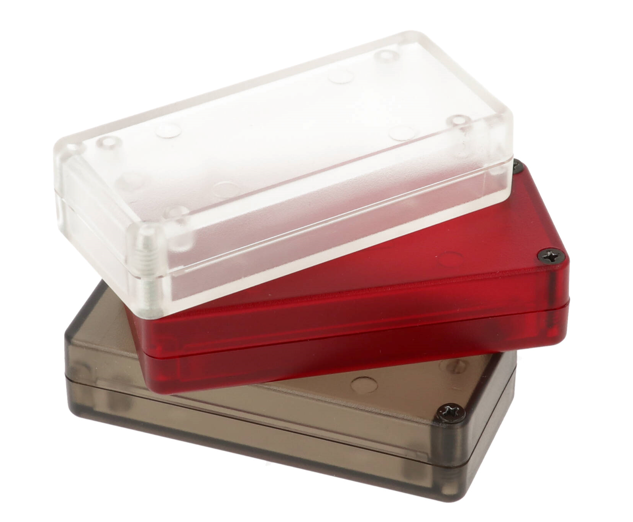
Polycarbonate
Polycarbonate is the rockstar of the plastic world. Offering superior impact resistance, a wide operating temperature range, and resistance to UV damage, it is the chosen plastic for many outdoor, high-impact, and marine applications. UV stabilized polycarbonate resists discoloration and becoming brittle due to sun exposure, and is naturally clear. Because of this it is often used for products like eyeglass lenses and racecar windshields, as well as high quality enclosures. Polycarbonate carries high flame retardance ratings. As expected, polycarbonate is therefore a less economical option than ABS, particularly at the start of a project, but its longevity even in harsh conditions can save costs in the long run.
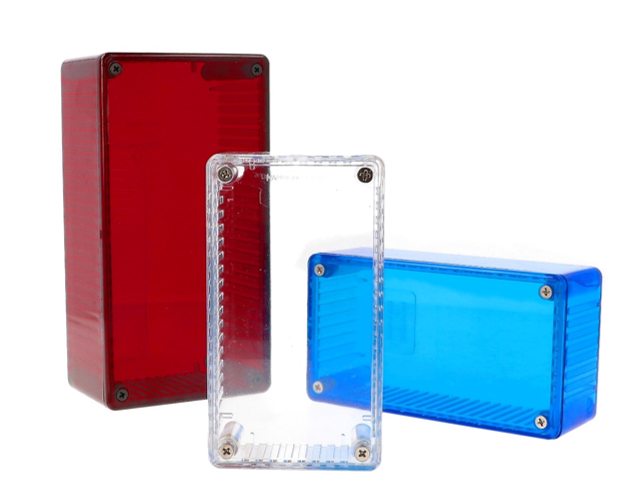
Fiberglass
Fiberglass-reinforced polyester, abbreviated FRP or GRP, is composed of polyester plastic reinforced with glass fibers. FRP, like polycarbonate, is suitable for outdoor use, with good impact resistance and a wide operating temperature range, wider even than polycarbonate. It may, however, be subject to discoloration by UV exposure. Because of its makeup, FRP can disperse glass particles when cut and specialized PPE and tools are required for modifying it.
Both polycarbonate and FRP offer good chemical resistance, with both ideal for use in salty environments. FRP withstands solvents and dilute acids and bases. Polycarbonate does well against acids and some solvents and alkalis. Always research the specific hazard before choosing a material.
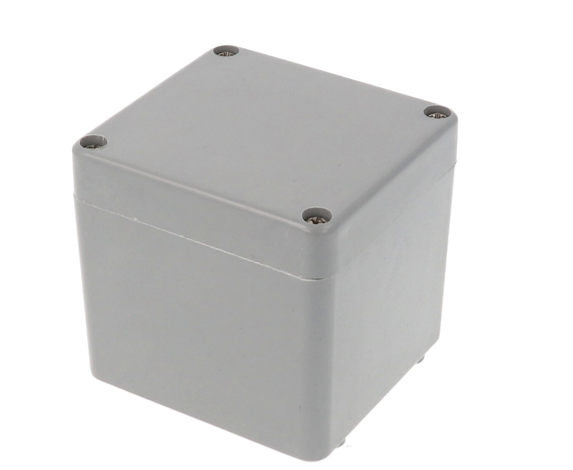
Metallics
Opposite to non-metallics, enclosures made of metal have better shielding properties against RFI and EMI.
Metal-to-metal contact is essential for full shielding as well as grounding, a process that is necessary for safety when dealing with electrical devices inside the enclosure. Metallics are generally acceptable for outdoor use and have good impact resistance.
With metals, it’s important to keep an eye out for galvanic corrosion, also called dissimilar metal corrosion.
If two different metals are in contact with one another, the one that is more “basic,” or gives up its electrons more readily, will begin to corrode at an accelerated rate, causing structural as well as aesthetic damage. Users should be careful not to use zinc-coated screws or a galvanized steel joiner with a stainless steel enclosure, for example.
Aluminum
Aluminum is a non-ferrous metal that is strong despite being a relatively lightweight material. In addition to the variety of forms it can take, such as sheet aluminum, extruded aluminum, and diecast aluminum, it also has different properties depending on which alloy is used.
An alloy is made up of the base material (aluminum) plus other metals or elements. Some alloys are stronger than others, or more tensile, or more accepting of certain finishes, and so on.
Aluminum is easy to process and form, and is the lowest cost metallic material for enclosures.
Diecast Aluminum
Diecast aluminum enclosures are produced by pouring molten metal into formed dies (also called cavities).
Diecasting is best for small to medium enclosures, so larger products will tend to use sheet metal instead of cast metal. The process is quick and produces a consistent product.
Diecast enclosures, as well as injection-molded plastic enclosures, have a feature called a draft angle. The walls of the box must be slightly angled outwards so that the enclosure can be properly removed from the cast. Therefore, the walls of diecast aluminum enclosures will have a slope of a few degrees.
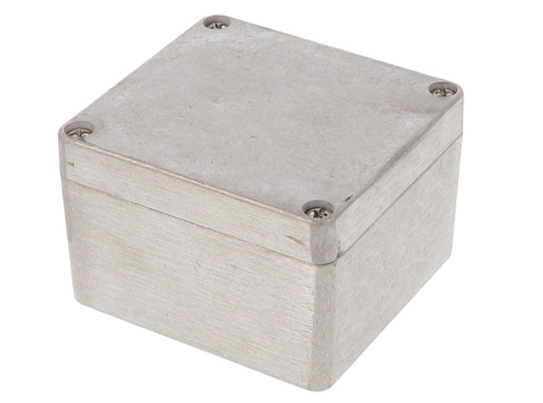
Extruded Aluminum
Extrusion also involves molten aluminum and a die, but rather than filling a cavity, extruded aluminum is forced through the die to take on a specific shape, creating very long pieces of extrusion which are then cut down to size.
Extruded aluminum enclosures are usually made up of an extruded tube and metal or plastic end caps.
Extruding large pieces that can be cut down is beneficial to a manufacturer, who can keep a stock of tubes on hand and provide a variety of enclosure lengths on demand.
Extruded aluminum enclosures materials at Hammond are supplied with an anodize finish. Anodizing is a process that increases the thickness of an enclosure’s oxide layer and makes the surface more durable.
Anodize can be applied in a variety of colors. Some aluminum alloys take anodize well and some do not; while Hammond’s extruded enclosures can be anodized, diecast aluminum enclosures cannot and are powder coated instead.
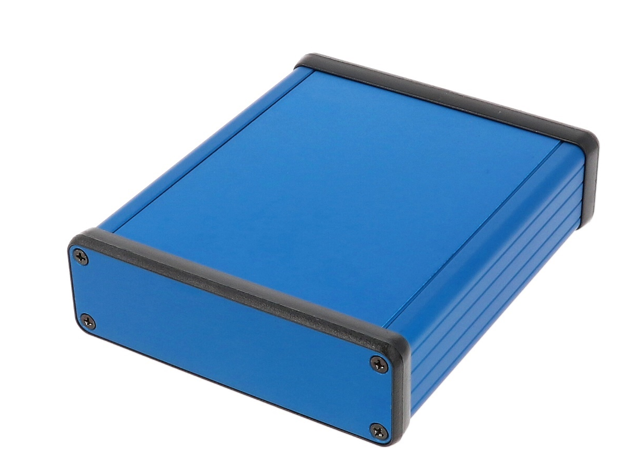
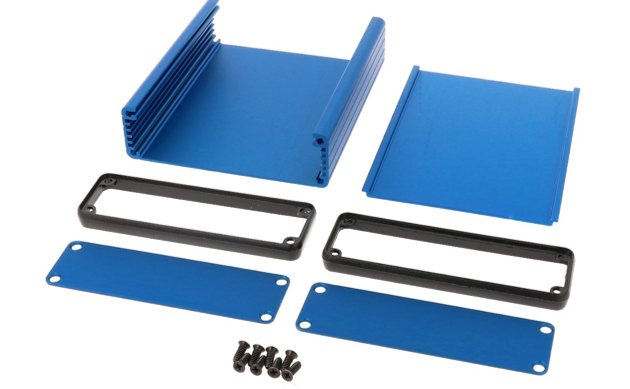
Sheets of aluminum can be cut and folded to create enclosures and panels. Unlike extrusions and dies, which are limited by the tooling features and dimensions, myriad enclosure designs can be made from folded sheet metal.
Aluminum sheets, especially at thinner gauges, do not support exceptional amounts of weight, and the sheet can be expected to bend or warp if overloaded.
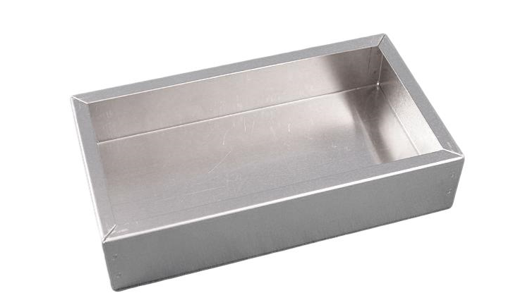
Steel
Steel is a widely used and reliable material across many industries. Steel is an iron alloy (made of iron combined with carbon).
Steel sheets are used to construct enclosures and panels, with a variety of steel types to choose from depending on the application.
Steel is heavier than aluminum and stainless steel in particular can be more costly.
Mild Steel
Also called “low carbon steel,” mild steel has a lower carbon content than standard steel and is easier to form and weld.
Mild steel is low cost and versatile, but oxidizes in weather unless it is finished. This is why mild steel enclosure materials have a powder coat finish, vs. stainless steel or aluminum enclosures which can be found natural, or with less finish.
Natural mild steel can be used for inner panels, as they will not be exposed to the elements.
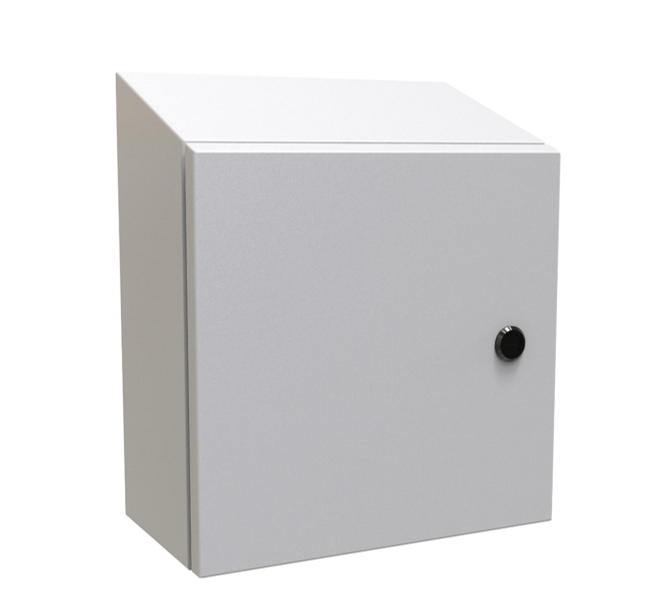
Galvanized Steel
Galvanized steel is made by dipping steel in a coating of zinc. This protects the iron-rich surface of the steel from corroding quickly.
Galvanized steel does not stand up well to super corrosive chemicals or marine environments.
Galvanized steel is a common material for inner panels and general purpose indoor commercial enclosures. When powder coated, it can be used outdoors in light conditions.
Stainless Steel
Stainless steel is an iron alloy that contains chromium, giving it corrosion resistant properties.
Different grades of stainless steel can be created by the inclusion of additional elements.
Stainless steel resists rust and does not need to be finished. It is highly resistant to acids, alkalis, and solvents, has great performance outdoors, and is easy to clean, making it ideal for hygienic environments like medical or food and beverage applications where the enclosure will be hosed down frequently.
The two most prevalent grades of stainless steel are:
- 304 – This is the most common grade of stainless steel.
- 316 – This is a more specialized grade that offers all of the above benefits of stainless steel plus extra corrosion resistance, thanks to the element molybdenum. 316 stainless is excellent in marine environments.
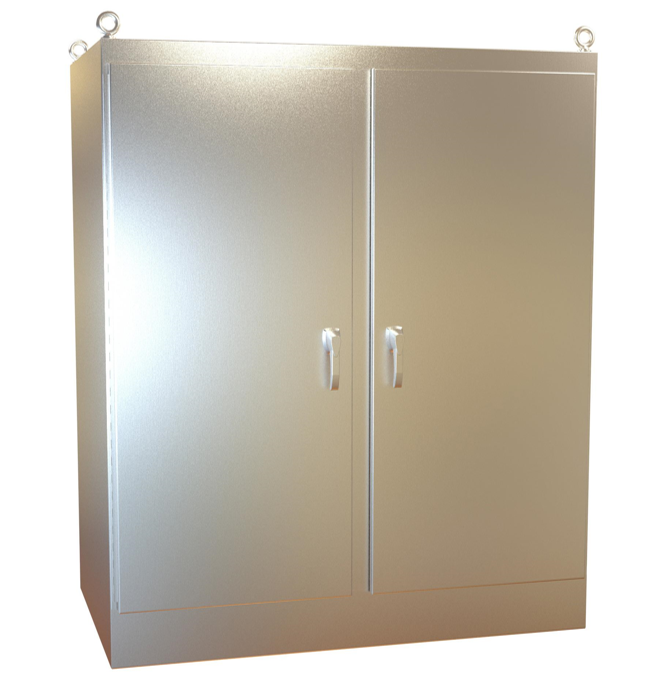
Figure 9: A freestanding stainless steel enclosure, Hammond part number HN4FS726036SS. (Image source: Hammond Manufacturing)
Ratings and Materials
An enclosure’s rating and its material go hand in hand, as rating systems like NEMA, UL, and IP judge an enclosure based on its performance under various conditions says Hammond.
NEMA – The most common rating system for industrial and electrical enclosures, NEMA types describe whether the enclosure is for indoor or outdoor use, if it is corrosion resistant, and how it performs against hazards like water and dirt. Some common NEMA types include:
- 12 & 13 – Indoor use, with some protection against dirt and dripping water
- 3R – Indoor or outdoor use, with protection against dirt and wet weather (rain, sleet, snow)
- 4 – Indoor or outdoor use, good protection against dirt, wet weather, and splashing or hose-directed water
- 4X – Similar to 4 but with the addition of corrosion resistance
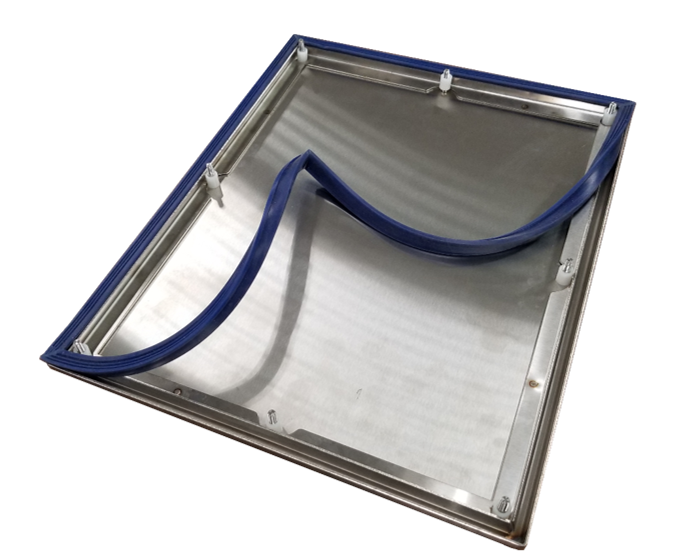
Figure 10: A hygienic blue silicone gasket lines the door of a stainless steel enclosure from Hammond’s HYW series. (Image source: Hammond Manufacturing)
Ingress Protection (IP) – IP ratings are determined by the International Electrotechnical Commission (IEC). IP is the more typical parlance for electronic enclosures but there is crossover between IP and NEMA ratings.
The first digit of IP ratings relates to dust-tightness, while the second digit relates to water-tightness. Some common IP ratings include:
- IP54 – dust-protected, with protection against splashing water
- IP65 – minimum rating to be considered water-tight, minimum recommended rating for outdoor use, dust-tight, with protection against water jets
- IP66 – dust-tight, with protection against powerful water jets
- IP67 – dust-tight, with protection against temporary immersion in water
- IP68 – dust-tight, with protection against continuous immersion in water
UL Listing – Products that are UL listed are tested by independent laboratories. Enclosures are held to the standards listed under UL 508A.
No water ingress should occur between tests; otherwise, the product fails to become UL listed.
Other factors, such as consistency of materials, factory processes, UV resistance, and flammability rating are also considered. UL listing is a valuable indicator of performance, quality, and safety.
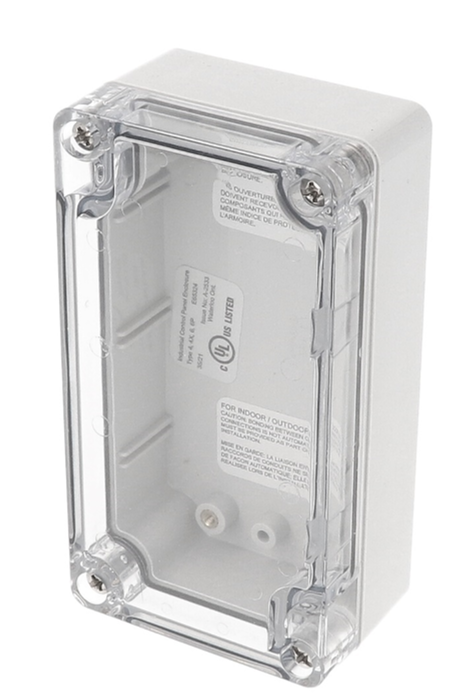
Conclusion
Designing an electrical or electronic assembly can come with a lot of considerations, but hopefully this overview of enclosure materials and ratings helps to streamline enclosure selection.
Whether the application calls for a simple plastic box for a handheld switch or a robust, stainless cabinet that must stand against salty air on a pier, housings are undoubtedly a vital part of any assembly.
The article is sourced from, DigiKey Website.




